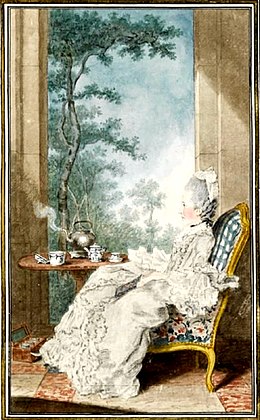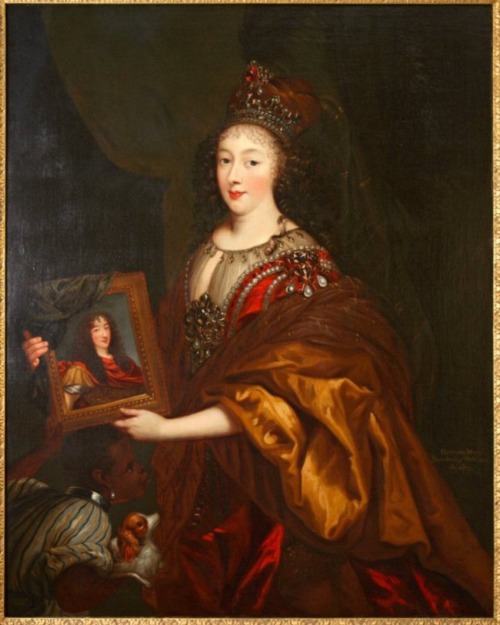Marie-Josèphe of Saxony entered Versailles as the second wife of Louis Ferdinand and as such immediately commanded a special position as Dauphine. Despite giving birth to no less than three kings her life at Versailles has been somewhat overshadowed. Still, there are ways to find an insight into her life; one is through the inventory of her possessions made up immediately after her death in 1767.
Amongst the Dauphine's numerous possessions were several jewels and precious stones. Not only does these give us an idea of her personal taste but also of the fashions at the time.
 |
| The jewels on Marie-Josèphe's bodice could very well have been a part of the Crown Jewels when she arrived in France |
The first set of jewelry granted to the new Dauphine were not new; rather they had belonged to the previous Dauphine, Marie-Thérèse-Raphaëlle, who had died shortly after her marriage. Given the price of the jewels in question it is hardly surprising that the king wanted to "recycle" them; after all the pieces in themselves were not exactly tainted by their former owner's demise.
The set of jewelry were made up of pieces that Marie-Thérèse-Raphaëlle had brought with her from Spain and others that Louis XV had given her on occasion of her marriage. The set was said to be amongst the most beautiful pieces of jewelry made in the 18th century. The set was comprised of a brilliant diamond parure or set.
Besides this magnificent present the Dauphine acquired several other pieces over the years. These included:
Shoe buckles shaped in an oval and covered in eight large diamonds
Earrings of pear-shaped diamonds
A tassel - probably meaning a pendant - of one large diamond surrounded by six smaller ones
Two ornaments for the sleeve in the same style as the earrings. These were made to accompany them as a set.
A diamond necklace with two pear-shaped stones and a little bow; these were worn with seven small "buttons". Most likely, these were more like small brooches that could be attached wherever on the gown than what is usually associated with buttons.
A jewelry case for a ribbon and its pendant as well as twelve diamond pins
Gemstones brought with her from Saxony. These included clusters of jewels, pear-shaped precious stones and earrings. A diamond-encrusted bow with a pear-shaped diamond as well as a smaller bow also came from Saxony.
 |
| This presumed portrait of the Dauphine shows her wearing two pieces found in her possession in 1767: the bracelet with a portrait of her husband and the aigrette with pear-shaped diamonds |
Large girandole earrings from Louis XV
A bracelet made of 290 brilliants
Two bracelets with the portraits of the king and the Dauphin respectively. The portraits were surrounded by small brilliants and held together by six rows of white pearls.
An aigrette with four pear-shaped diamonds
Shoe buckles designed with flowers of diamonds
A cross of brilliants
A brooch shaped like a bouquet of white and yellow diamonds and rubies
A bow of diamonds and emeralds. This particular piece is mentioned in connection with dressing-gowns so it is possible that it was used to close her dressing gowns.
 |
| The necklace could possibly be that which was made of Oriental pearls. The brooch show another portrait of the Dauphin |
A bow of diamonds and emeralds with a pear-shaped diamond
Earrings with pendants of emeralds and diamonds
A ring with an emerald lozenge and four small brilliants
An aigrette with brilliants and emeralds whose middle forms a Holy Spirit with five pear-shaped diamonds
An aigrette with three pear-shaped stones: two brilliants and one emerald
An aigrette with a large ruby and pear-shaped diamonds; also this hair-piece had flowers of diamonds and rubies
A pair of earrings with rubies and brilliants
Very large, round earrings in pink
Two bracelets of six rows of pearls
 |
| The pair of three-rowed pearl bracelets features portraits - presumably those of the king and the dauphin |
A golden fan encrusted with amethysts and brilliants
A six-row pearl necklace
A large necklace of 23 Oriental pearls
A fan encrusted with mother-of-pearl, pearls, brilliants and rubies
A watch and accompanying chain with diamonds
A collar with a pair of girandole earrings. These were decorated with topaz from Saxony and came with a case - another three small diamonds came with the case.
A bracelet of seven rows of pearls with brilliants and emeralds
A bow with a large, square Spinel (ruby-like) stone with diamonds and rubies
Obviously, the Dauphine did not lack for options! The total worth of these pieces were 737.762 pounds. The estimate was done by the royal jeweler who carried out the estimation on 21 June 1767.





